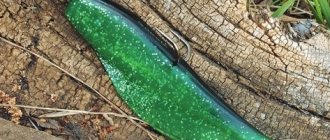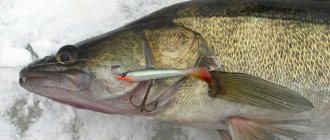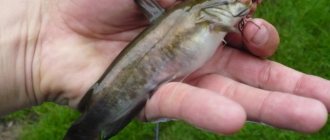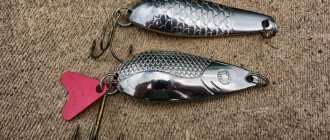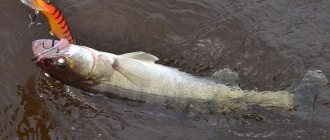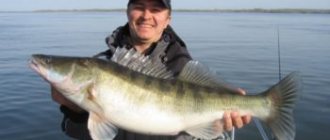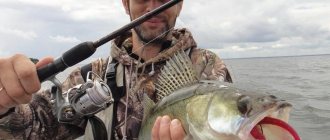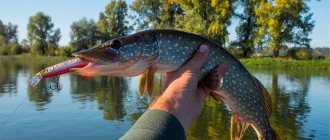Spinning fishing for predatory fish in the Lower Volga, including Akhtuba, is
perhaps one of the most exciting and sporting types of fishing. Here, in Three Rivers, the confluence of the Akhtuba, Mangut and Kharabalyk riverbeds, there are excellent places for catching such coveted trophies as pike perch, pike and catfish using artificial bait. These places are rich in large carp, asp, perch and bersh. Among the many fishing tackles, devices and artificial baits for actively catching predators, it is worth talking separately about a special type of spinning fishing - fishing with a foam rubber bait with a sinker
with a jig head, or simply - fishing with a foam rubber fish (foam rubber). It will be even more interesting to discuss the features of using foam rubber bait on a predator in conditions of strong currents, great depths and an abundance of snags, characteristic of river beds and channels of the Akhtuba floodplain.
What is a foam fish?
This artificial bait, amazing in its simplicity and at the same time unusually catchy when handled correctly, appeared in the arsenal of domestic fishermen relatively recently, after its invention about thirty years ago by sports fisherman S. Pavlov. Initially, foam rubber was aimed at catching pike perch from the bottom in spring and autumn in large standing bodies of water - lakes and reservoirs. However, over time, it turned out that fish made from soft foamed polymer, due to its properties and the simplicity of various modifications, works great for catching pike, perch, and often catfish, and even during certain periods - asp. Anglers have adapted to successfully fishing with foam rubber and in strong currents. In essence, foam rubber is a painted or simply colored piece of foam rubber of an elongated shape (bar, olive, cigar, “coffin”) with additional external elements and with a hook inside the body, hinged to a sinker in front. That is, the design is fundamentally reminiscent of a jig rig, when a silicone bait is hingedly attached through an offset hook to a Cheburashka sinker. However, the game of a foam rubber fish is fundamentally different from the “behavior” of twisters and vibrating tails made of silicone, which we will discuss below. And most importantly! The simplicity of making a foam fish with your own hands, and therefore the minimum cost, the ability to experiment and modernize a homemade bait ad infinitum, and excellent catchability quickly gained popularity for this type of fishing for predatory fish. Why does foam rubber have high catchability? But because spinning fishing with artificial foam baits is essentially a combination of 2 fishing methods: - “jigging” with horizontal stepped retrieving; — vertical trolling “in a plumb line.”
Photo of a foam fish
Note!
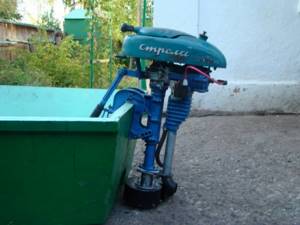
Do-it-yourself boat motor - tips for beginners, projects, drawings and step-by-step description of the construction of the main components and elements (video + 120 photos)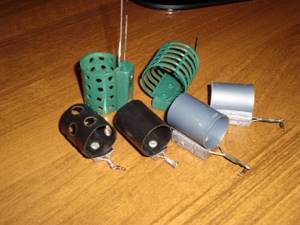
Feeder for winter fishing - secrets of use and techniques for feeding fish in winter (115 photos)
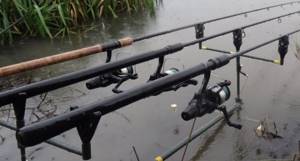
Bottom gear - the most effective types of equipment and features of casting techniques (95 photos and videos)
Read here DIY anchor: drawings, sketches, diagrams, photos and videos describing the construction of simple and effective homemade anchors
Help the project, share on social networks 

0
The main and very significant advantages of artificial foam bait:
— hooks (single, double or treble) are easy to fix in the required position, it is easy to change the position of the hooks to catch a certain type of predator (for example, a pike attacks prey across the head, and a pike perch in the forehead from the head); — when attacked by a predator, foam rubber, unlike plastic and metal, does not provide resistance to the jaws of the predator and, as a result, increases the efficiency of detection; — having greater buoyancy, the foam rubber dampens the impact of the sinker on the ground during stepwise retrieving, which makes the play of the entire tackle more natural; - very accurately imitates a fish digging at the bottom, since the body of the foam rubber itself is in a vertical or almost vertical position during pauses and falls, the potential victim of a predatory fish is more attractive precisely at the moment when it is busy or moves in an unusual way - which means it is weakened ;

- water-impregnated foam rubber is closest to the natural properties of the body of a predator’s natural prey and does not cause him excessive alertness due to the “strange” reflection of fluctuations in the aquatic environment (fish sense the world around them by vibrations of water perceived by the sensitive organ of the body - the lateral line).
Where to catch crucian carp with artificial bait?
The first thing I want to warn you about is that crucian carp bite on artificial baits much worse than rudd, roach and carp, so don’t count on a large number of bites.

Also take into account the fact that in some reservoirs crucian carp do not bite at all on spinning baits, because they feed mainly on plant food.
In order to make the most of it, try catching crucian carp with a spinning rod on reservoirs where floaters and feeders catch it with a worm, maggot and leech.
The chances of being caught in such places are very high! Consider another important point: next to the crucian carp, in many reservoirs there is a perch, which will certainly pester you with its bites.
If striped fish bites are unacceptable to you, I advise you to choose ponds where crucian carp is the dominant species.
By the way, in reservoirs densely populated with crucian carp, the chances of a good bite are disproportionately higher for the additional reason that due to high food competition, crucian carp becomes a semi-predatory fish.
Features of equipment with foam rubber fish for catching predators in the current
Let us immediately note that the conditions for catching pike perch, pike and perch with foam fish in the Akhtubinsk Three Rivers area are not easy. Complex bottom topography, meandering channels, strong currents with a complex structure along the horizons and cross-section of the channel. But there are also advantages to this - an abundance of places suitable for large predatory fish for ambush and shelter and, accordingly, a large number of trophy fish. When fishing in such conditions, the foam rubber bait must meet the following requirements: - hooks should be placed in the head or immediately behind the head of the foam rubber, but no further than one third of the body from the head. Otherwise, the fish’s game comes to naught; - for conditions with a strong current, the length of the fish should be no more than 12-18 cm. Smaller ones will not attract a large predator, and larger ones will not provide the opportunity to achieve the correct game; — the shape of the bait is very important in relation to what type of predator is intended to be caught. Pike-perch and asp prefer runny, elongated

shapes reminiscent of their natural prey (fry and small elongated fish such as bleak, roach, etc.). Pike and perch, depending on the size of the bait, may not pay attention to the shape, especially during feeding or active biting. In any case, when making foam rubber, you should strive to give the fish’s body a shape and proportions that resemble a living analogue; — coloring and coloring of foam rubber bait is very important in clear water, in good lighting and when fishing at depths of up to 3-4 meters. In all other cases, the color of the bait attracts only the angler himself; - when making or choosing a foam rubber, you should not try to achieve complete similarity with the living original - it is pointless. Therefore, more attention should be paid to the form and “fixtures” that change the game of the fish. For example, instead of making detailed colored roach fins, which can worsen the performance of the bait, it is better to attach bright red wool in place of the fins; - the spinning rod for catching a predator with a foam fish is chosen the same as for fishing with a classic jig - rigid or semi-rigid with a braided cord as the main fishing line. When making the body of a “fish”, you can use various types of colored foam rubber. Soft foam, when saturated with water, reacts well to all movements of the load head, while hard foam, on the contrary, almost always remains in an upright position. The caudal fin is needed to create additional turbulence in the water, attracting a predator. There is no point in making the remaining fins, but you can imitate them with pieces of bright wool - this will not affect the performance of the bait.
Techniques and places for fishing with foam fish
Many visitors and local fishermen from those who

loves active, sport fishing for predators. This tackle, in principle, should be in any fisherman’s fishing box, if only because such tackle may be needed at any time. There was a case when a predator did not take any bait other than a jig, and at that moment the foam rubber outsold even the “horsemen” by a factor of two. In the conditions of Three Rivers (river beds and channels of the Akhtuba floodplain, Lower Volga), the choice of a place for catching predatory fish, for example, pike perch or pike, presupposes the presence of at least: - a riffle with a drop into depth at the border of the direct and reverse flow (all types of river predators are found here ); — a serious, up to 8-12 meters deep, river-bed hole with accessible access for fishing to depths of 4-6 meters (pike perch, catfish); — a bend with an underwater spit, followed by several bottom gutters oblique to the axis of the channel (large pike love these places); — driftwood and snags anywhere no smaller than 2-3 meters (large pike perch and pike); — whirlpools under the pits with depths of 5-8 meters (the size and type of the trophy is unpredictable, but in the summer the foam rubber works here too. So 2 years ago a catfish worth 29 kg was caught with a foam rubber from the shore). You can catch pike and pike perch, as well as perch and sometimes asp or catfish, with this convenient and low-budget bait in the current both from the shore and from a boat. When fishing with foam rubber from a boat, the bait is sent and carried from the shore to the depths under the boat. To do this you will need a boat with a motor (the currents here are very strong). This is the most natural way to move the natural prey of your future trophy - fry and juvenile fish. If the place is chosen correctly and there is an intuitive feeling that a large predator is standing HERE, pull the fish from the shore to the vertical under the boat - the action of the foam rubber does not change when the angle of the main line relative to the bottom changes. You can anchor about 20-30 meters from the drop you like and try to “pump” the bottom with a fan, starting almost from the edge of the bank in the order from the upstream point to the bottom. There are many places in Three Rivers where the technique of fishing with foam rubber can be mastered from the shore. Having identified a promising area for fishing, you can carry out the same fan casts of the fish with tapping the sinker on the bottom in the opposite direction, from the depths to the shore. The difference will be that after each pull with the rod, more energetic than in the case of jigging from a boat, you need to quickly reel in the line during pauses, not allowing it to sag. In such a situation, contact with the bait is lost for several seconds, but these seconds, according to experience, are the most important - according to statistics, pike perch most often hits the bait while falling, and large pike pause, while stopping. When working with foam rubber fish, its non-clinging property is also important. Fishing with a foam rubber from a boat is the best option to catch a large single pike perch or pike from a snag at the bottom of a hole or a flooded tree, under the cover of which these predatory fish usually set up their hunting ambushes. The fact is that pulling bait from the shallows to depth is much safer in terms of hooks compared to shore fishing. In such a situation, a greater number of predator attacks are recorded, and there are fewer “deaf” hooks. By the way, these few meters before the bait, sliding from the shore, reaches a depth of 4-6 meters and require the author of the foam rubber to apply coloring to the bait and design “eyes” - at such a depth, especially during the day, even a blind pike will pay attention on the appearance of his future victim. Unlike deep-sea pike perch, pike treats the appearance of foam rubber bait with great prejudice, which cannot be said about an aggressive schooling predator
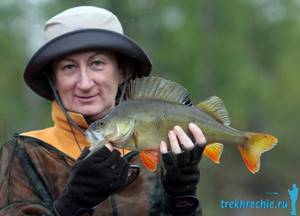
perch - this one, if there is an appetite, attacks “everything that moves” and does not pay attention to either color or shape. If only it could be swallowed. And the predilection of a large perch for the little ones swarming at the bottom is evidenced by the fact that it cannot miss a microjig or small silicone on a retractable leash with a load.
Why foam rubber?
Why is “foam rubber” so good? Why has it become so mega-popular among pike-perch fishermen? There are several reasons for this.
- Ease of manufacture. The fish is easily cut out with scissors and does not require any painting or complex processing. Even a child can make it.
- Easy to use. No special installation required. Jig equipment, retractable leash - everything that is applicable to silicone baits.
- Efficiency. It has been noticed that using a foam fish can stir up even the most passive fish, which refuses to take on anything else.
- Versatility. “Foam rubber” can be fished in any body of water, at any depth.
- Cheapness. By purchasing a set of sponges for washing dishes, you can provide yourself with colorful fish for the whole season.
Read: Cranks as an effective and simple way to catch perch or pike
It is necessary to make a reservation that the fish that are sold in stores do not meet the criterion of cheapness. On the contrary, industrially produced “foam rubber” costs quite a lot. But practice shows that they are no different from the bait that was cut out in a minute in the kitchen.
Another positive quality of foam rubber is non-sticking!
More than once, you probably had to look at a huge flooded tree protruding from the water, fantasizing about what kind of fish, what huge pike perch and pike were calmly resting in its underwater branches. But how can you have such a bait in order to get there and not tear it off like the last castmaster was lost yesterday. There is such a bait!
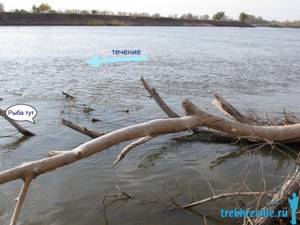
With some experience and dexterity, foam rubber equipped with non-snagging hooks can be effectively used in heavily snagged areas. It is here, in places inaccessible to trollers and fishermen using classic lures, that large pike perch and trophy pike stand. And if trollers go around a tree submerged in a hole a mile away, then God himself ordered them to look here with a foam fish. An important rule that allows you to reduce the likelihood of snagging on snags by at least 1/3 is to install the hook at a greater distance from the weight head through a wire extension. This is how they work with such bait for pike perch. They stand from a drift block 20-30 meters upstream and send the bait a few meters from the snags. Allow the bait to “fall” into the rubble, deep into the snag. A sign that the bait is safely falling down through the blockage is the frequent tapping of the weight head against obstacles, which the spinning angler sensitively senses through the vibration of the rod. Sometimes it is not possible to “break through” the blockage the first time and the procedure has to be carried out several times. In case of a bite or suspicious movement of the sinker, the hook should follow immediately, but without unnecessary “fanaticism”. Fishing for pike perch from snags is carried out in a forced way, that is, by force, quickly and without giving any slack to the main line. If you have to fish with a foam rubber in a very strong current, and there are plenty of such places in Three Rivers on Akhtuba, you can put an additional bullet-shaped weight on a metal leash - you get something like a “Carolina rig.”
Composite foam rubber for catching pike and pike perch
When catching pike with artificial bait, the retrieve should be done in a sweeping manner, with a large vertical amplitude and reeled in quite quickly. Pike loves rapid movement. But when using a composite (of two or more parts) foam rubber bait, there is no need for this - the pike will already be attracted to the unusual movements of the bait at the bottom. You've probably noticed that pike are generally very greedy for composite baits (including wobblers), so in a composite fish made of foam rubber, a well-made tail is very important, which constantly moves even with a long pause - the current affects it. If, after several trips to a promising place, there are no pike bites, then this means that it is not there at all, or it is in a stupor and does not feed at all, that is, it is useless to catch pike now and you need to move on to other types of fish. Now the number of derailments has decreased, and the number of hooks has not increased. Moreover, during testing, I noticed that the performance of the bait had improved and an additional degree of freedom appeared.
Technique for catching pike with foam rubber
The basic technique for catching pike with foam rubber is the classic step retrieve. To complete it, you must:
- wait until the equipment sinks to the bottom after casting;
- make 2-3 turns of the reel handle;
- pause, allowing the bait to fall to the bottom again;
- rewind the line again.
stands vertically 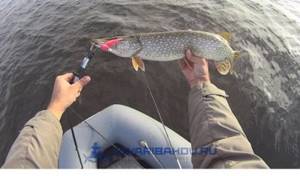
Another variant of the animation technique is step-by-step fishing with a rod. To perform it, you need to jerk the tip of the spinning rod and immediately take out the slack in the fishing line , pause and make another swing. Thus, spinning jerks and pauses alternate until the bait reaches the shore or the boat.
Thus, there is nothing complicated about fishing with foam rubber . In this type of fishing, classic jigs . But foam fish differs from standard silicone jig baits in its working qualities .
Therefore, it is worth trying it in practice to evaluate its benefits. A foam rubber can work great in a situation where the pike is reluctant to attack the twisters and vibrating tails offered to it.
Features of equipping a foam rubber for catching pike perch in snags
For this technique of catching pike perch, you will need a fish made of stiffer foam rubber and sensitive to any movement of the load. A composite fish made of hard foam rubber fluctuates well in the current, since there are no special opportunities for the fisherman to manipulate the wiring in the branches of a flooded tree. Of course, such a bait has more windage, but it plays well with a stationary load, which is very attractive for large pike perch, which likes to ambush precisely in such sloughs. By the way, it is this type of foam rubber that most often catches asps, although foam rubber is not the main bait for catching asps. Tests on Akhtuba of all kinds of anti-hook tricks led to the fact that the use of offset hooks for catching predators with foam fish had to be abandoned due to low efficiency. Hooks equipped with antennae or a steel cord frame provide the most reliable protection from snagging. When biting, these elements do not prevent the fish from hooking, but more or less successfully protect against snags.
The old fisherman's secret on how to make a very catchy foam rubber

The main secret lies in the use of special substances that will first disinfect the bait and then give it the necessary aroma. The process of making such a bait takes no more than an hour, and the materials used are everything that any angler can definitely find at home. Tools and materials for creating bait: - scissors; - bowl; - a piece of foam rubber; - sealed bag; - potassium permanganate; — flavor (attractant); - brush; - offset hook with weight; - some water.
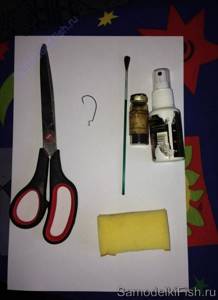
Bait making process
Step one. Making a foam fish
You need to take a piece of foam rubber and cut a blank from it using scissors.
The result should be a classic “carrot”. Next you will need to cut out the head of the bait. After this, you can install the offset hook. To attach the hook, you need to use threads, making a couple of turns around the hook along the foam rubber in the bow. Otherwise, the foam will slide off upon contact with any obstacle. Step two.
Disinfection of bait Many fishermen here may be perplexed, why should foam rubber be disinfected? But the author claims that it is precisely this approach that makes the bait very catchy. The thing is that during disinfection, microbes die, and they, as you know, are carriers of odors.
A solution of potassium permanganate is used as an antiseptic. The foam bait must be thoroughly soaked in the solution using a brush. Then you need to wait until the foam dries. Potassium permanganate can be found in old car first aid kits.
Step three.
Using an attractant Now comes the flavoring. The foam rubber must be thoroughly soaked in flavoring. You also need to take a sealed bag and treat it with flavoring from the inside. After this, the bait is placed in a bag and hermetically sealed. According to the author, now the bait should lie in the bag for at least a day. Only then will it fully absorb the aroma.
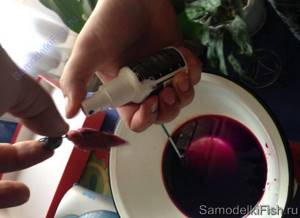
That's all, in a day the foam rubber will be ready for use. First of all, such baits work great in places with strong underwater vegetation, since an offset hook is used here and it is very difficult for the bait to catch on anything. Well, the main highlight of this tackle will, of course, be its rich aroma, which should provoke the predator. Source
Become the author of the site, publish your own articles, descriptions of homemade products and pay for the text. Read more here.
How to go fishing for the first time on Akhtuba? Just!

In conclusion, I would like to note that now you have a great opportunity to go fishing and relax comfortably in Trekhrechye on Akhtuba at the fishing base of the same name - Fishing Village “Trekhrechye”. This is a picturesque place
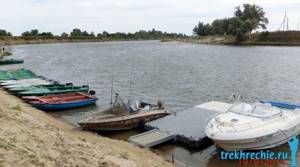
Rassvet Island, formed by the beds of the Akhtuba, Mangut and Kharabalyk rivers, is known for its fishing grounds and diversity of flora and fauna. You can fish here from a boat, from the shore, in riverbeds, on eriks and ilmens for all types of fish and with all permitted gear. And the friendly staff of the base and experienced rangers will always help you get comfortable in a new place.
More

